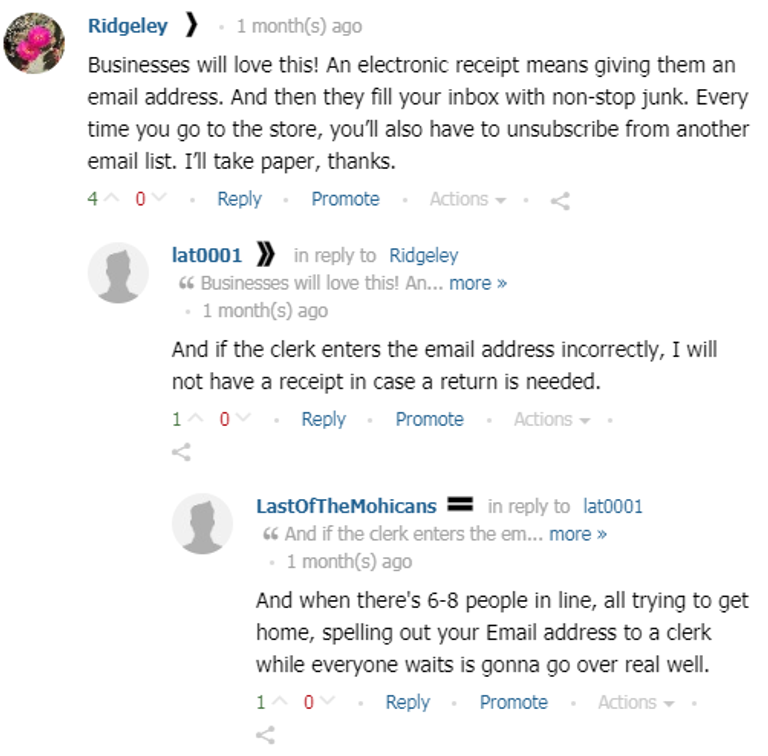
California Assembly Bill 161 may change the way you get receipts
Imagine this situation: you’re in line paying for some groceries, and the cashier prints you a receipt for your transaction. You briefly look at it and proceed to the nearest trash can to throw it away.
Here’s another one to consider: you’re grabbing dinner at your favorite restaurant, and you’ve just paid the bill. The server brings you two receipts - a merchant copy and a customer copy. You tip your server (hopefully well!), and sign the merchant copy, leaving the customer copy to be thrown away.
If I were a betting man, I’d wager you’ve probably been in either situation, if not both, at some point in your life. The listed scenarios are only some of the ways that paper receipts end up in the trash, but that may all change in the near future. Legislators in California are currently working on a bill to reduce the amount of waste generated by paper receipts.
What is California Assembly Bill 161?
Early in January 2019, California Assemblyman Phil Ting, D-San Francisco, introduced legislation that would require stores to automatically default to electronics receipts, unless a customer specifically asks for a paper receipt. California Assembly Bill 161 has already passed its first hurdle in the California State Legislature in late March and has already seen a slight update in late April.
Under the new bill, lawmakers would restrict the printing of paper receipts, specifically if a customer refuses a copy of his/her receipt. Their current plan is to give businesses until January 1, 2022 to comply with this aspect of the bill, and by January 1, 2024, businesses must provide an option for electronic receipts. After two warnings, violators would be subject to a $25 fine for each day the business is in violation, with a $300 annual cap.
AB 161 heavily referenced the findings from Green America’s report, “Skip the Slip: Environmental Costs & Human Health Risks of Paper Receipts with Proposed Solutions.” The organization reported that each year in the United States, more than 3 million trees and 9 billion gallons of water are used in the production of paper receipts. To provide another perspective for the everyday readers, the amount of trees used in the annual production of paper receipts (3.32 million to be a little more exact) is the equivalent of cutting down every single tree currently in Central Park... 127 times… every year.

Subsequently, the waste generated by paper receipts is also staggering - 302 million pounds of solid waste and 4 billion pounds of carbon dioxide emitted into the atmosphere, with the latter being equivalent to more than 425,000 cars on the road. Any reasonable person might suggest that we recycle these paper receipts along with any other paper products, but according to the report, most paper receipts contain chemicals that make them difficult to recycle, especially since they contaminate other recyclable paper materials.
Why It Matters - the Potential Nationwide Impact
AB 161 was modeled similarly to a recent California state law that requires restaurants to only give plastic straws upon request. California was the first state to not only curb the use of plastic straws, but it also imposed a statewide ban on the use of plastic bags in 2016. Though you might not live in California, you may have seen the effects of these regulations in your local grocery store or restaurant.
Why is that?
With a bustling tech sector centered in Silicon Valley, a global entertainment capital based in Los Angeles, and a total population of nearly 40 million people, California’s $2.7 trillion economy is the 5th largest economy in the world, which means its laws and regulations have a wide-spreading impact beyond its own state lines. Businesses operating in California must comply with these laws (I know, shocking right?), and if they have locations in other places around the country, you’ll often see the effects of those laws carried through to their other locations.
California has also long been a trendsetter with environmentally-focused laws, and other states have easily adopted the successes or learned from the failures of one of the largest economies in the world. Take a look at the trickling effects of the ban on plastic bags. Following California’s lead, New York recently became the next state to impose a statewide ban on the use of plastic bags, and a continuously growing list of cities across the U.S. have implemented similar rules to curb the use of plastic bags.
If AB 161 were to pass in California, we can be sure to see other states and cities follow in line. In fact, Illinois Representative Aaron M. Ortiz has already introduced a similar bill modeled after California Assembly Bill 161. As other politicians become more aware of the issue, we could see similar bills being introduced in more state legislators across the country.
Consumers are Concerned for Different Reasons
For years, consumers have gone to social media to voice their opinions about long paper receipts, especially those found at CVS. Take these Twitter users for example:
Literally Not a single soul:
— Daniel J adrays (@the_short_boy) May 3, 2019
CVS receipts: pic.twitter.com/2L7vISlV9O
The only thing Earth wants for her birthday is for CVS to stop printing out such long receipts. #EarthDay2019
— Jeremy McLellan (@JeremyMcLellan) April 23, 2019
I like the long CVS receipts, it’s as close as you get to unraveling a king’s decree.
— Mike Ginn (@shutupmikeginn) April 16, 2019
Even widely-known celebrities like Jimmy Kimmel have also stated similar thoughts:
Though these people might support a bill like AB 161, other consumers will find the ban on paper receipts concerning for other reasons. Briefly scroll through Twitter or the comment section on other articles written about this bill, and you’ll find mixed reactions, with negative comments focused mainly around privacy. Here are a couple examples taken from this article by the Los Angeles Times, published in late March 2019:
I could go on, but you probably get the point. Though the comment section on any article isn’t the first place most writers would go to for materials, it may be something important to at least consider in this case. These comments are the voices of real, disgruntled consumers who may be affected by this potential new law.
Privacy has long been a concern among consumers who opt out of using digital receipts. Concerns of being bombarded with marketing emails or possible robo-calls are both valid reasons for opting out of digital receipts. Not to mention, inputting personal information at the point of sale while other shoppers wait in line sounds like a recipe for extra unwanted time at the register. While some consumers manage to do fine with the currently available options, others are clearly looking for something different.
Making the Case for a Different Solution to AB 161
Given the current technologies available to us, there has to be something out there that solves the needs of both consumers and businesses. If you factor in all of the costs for receipt paper, ink, receipt printers, and even the time spent by an employee to service these receipt printers, the costs for printed receipts start to add up, especially as a business scales in size. Printed receipts are miscellaneous expenses for most consumer-driven businesses, and most of the time, they end up in the trash anyways. Emailed or texted receipts work for some, but to others, the privacy concerns are a difficult hurdle to overcome. With the potential ban and the current problems in mind, it beckons the question: what else can we do?
I’m going to suggest a different solution: scanned receipts. Specifically, I’m talking about scanning a QR code to get your receipts. It sounds simple, but here’s why and how it could work.
QR codes have been around for awhile, but in the last several years, they’ve made a significant comeback. I wrote a more in-depth piece about the not-so-surprising comeback of QR codes, but to boil it down to a few words, you see them everywhere now, from daily advertisements to product integrations like Snapchat and Pinterest. Because how long they’ve been around and their current prevalence in society, QR codes have become a technology that’s rather familiar to most consumers.
Speaking of most consumers, according to the latest mobile consumer study conducted by Deloitte, 85% of consumers in the U.S. own a smartphone, the majority of which now come with built-in QR code scanners. In other words, consumers currently have access to QR scanning technology on a massive scale.
However, the best reason for scanned receipts is that they will resolve many, if not all, of the privacy concerns currently surrounding digital receipts. Scanning a QR code is a one-way transaction of information from one screen to your smartphone, which means there’s no exchange of personal information for something like a receipt.
From a business perspective, scanned receipts also make a lot of sense. Using an API like QuickReceipts, you can turn almost any existing point of sale screen (i.e. tablets, credit card machines, etc.) into a digital receipt generator, which means cost savings in the form of thermal receipt paper, ink, receipt printers, and even employee time servicing empty printers. Scanned receipts give both businesses and consumers an accessible and affordable “green” option, which environmentally-conscious customers and employees can both support.
Not to mention, scanned receipts are fast and will get even faster in the coming years. As evidenced by the nearly 40% increase in 2018, internet connection continues to improve each year, and with the emergence of 5G, we’ll be able to power and experience new consumer technologies at an unprecedented level. This level of connectivity means that customers will have a fully loaded copy of their transaction, in hand, before they even leave the checkout lane, removing any bottlenecks that could result from inputting personal information at the point of sale.
The future of AB 161 is still up in the air, but even if it doesn’t pass, it’s time to start thinking ahead of the issue. If the environmental impact isn’t enough to persuade you, maybe the previously-discussed shift in technology might change your mind. Either way, it’s worth the discussion.
If you made it this far, thank you for reading! Check out our other blogs, reach out to us on Twitter @QuickReceiptsCo, or visit our website at www.quickreceipts.co.





